
FEBRUARY 18, 2022 POST: The Devil’s Backbone run via River, Hugo and Purgatory Roads with a stop by the Wildflour and a bonus ending.
OCTOBER 21, 2021 PREMIER POST: Brance Arnold and Sonic Radio at Koozies Ice House & Grill. READ MORE Fellow traveler Walt at The Lighthouse Inn. READ MORE The Story Behind Road Portraits. READ MORE Shot on iPhone. READ MORE

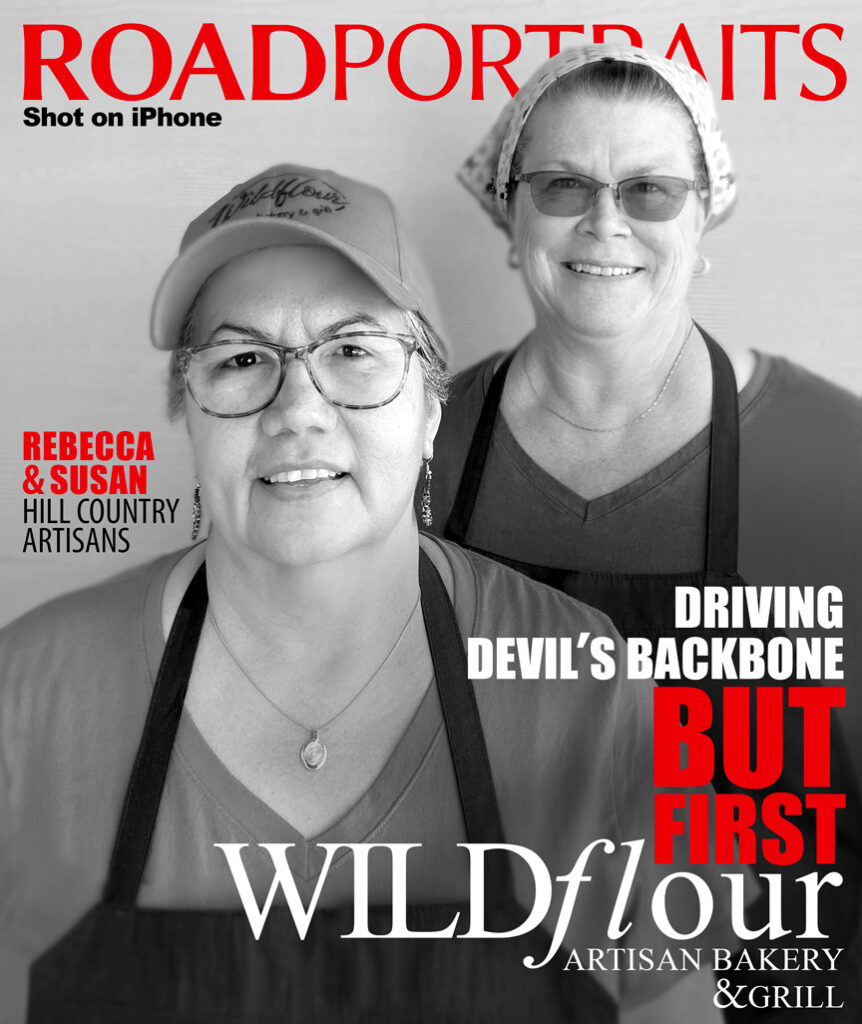
REBECCA & SUSAN, CO-OWNERS, WILDFLOUR ARTISAN BAKERY & GRILL.
Driving Devil’s Backbone.
The definitive (we hope) Devil’s Backbone route via River, Purgatory and Hugo Roads with a stop by the Wildflour Artisan Bakery & Grill (and ending with a bonus finish).
WRITTEN & PHOTOGRAPHED BY: STEVE HOLLOWAY
NOVEMBER 21, 2021. Devil’s Backbone, Texas.
We started our Devil’s Backbone road trip on River Road where it meets Loop 337 in New Braunfels. We headed northwest, winding along and criss-crossing the Guadalupe River for 13.6 miles to The Wildflour in Sattler.
While not formally a part of Devil’s Backbone, this short drive is a scenic precursor to the Backbone with three river crossings on a tree-lined road. Depending on the time of year, you will either be almost alone, see thousands of tubes floating downriver or watch one of the many area car clubs fly by (we drive this route often and have seen all three with car clubs including BMWs and Mustangs).
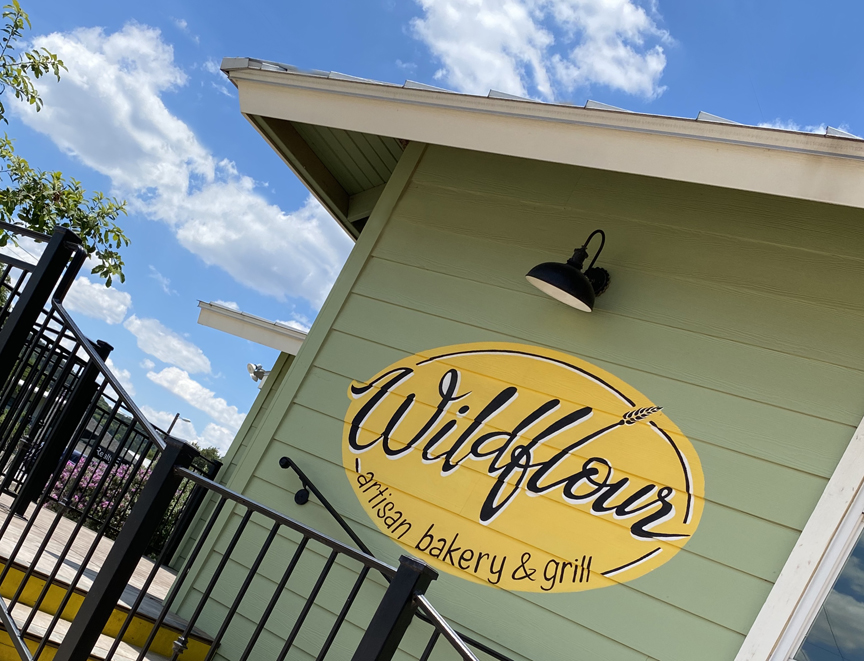
First Stop, the Wildflour Artisan Bakery & Grill.
Take a road trip to Canyon Lake and you’ll find two restaurateurs who have chosen to call the hill country home, Rebecca and Susan, founders and co-owners of The Wildflour.
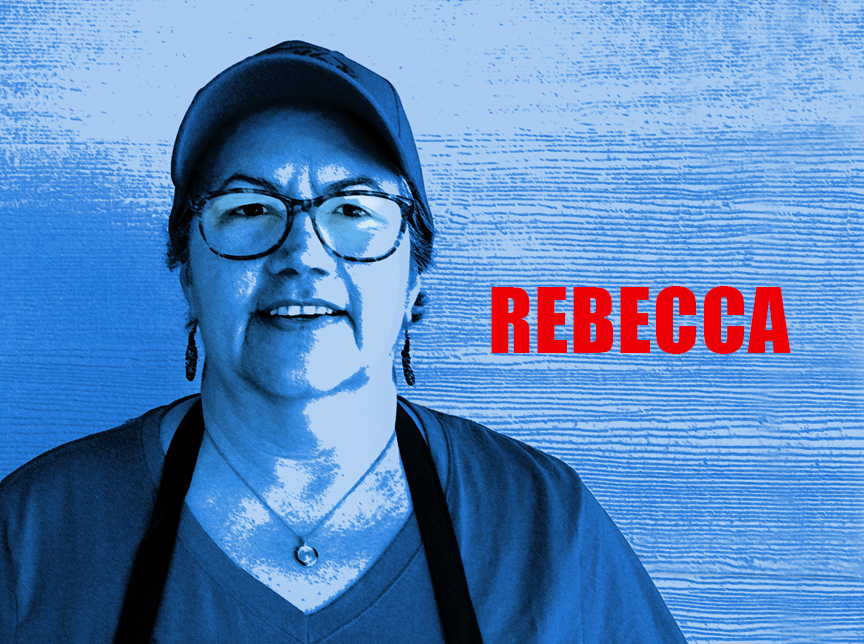
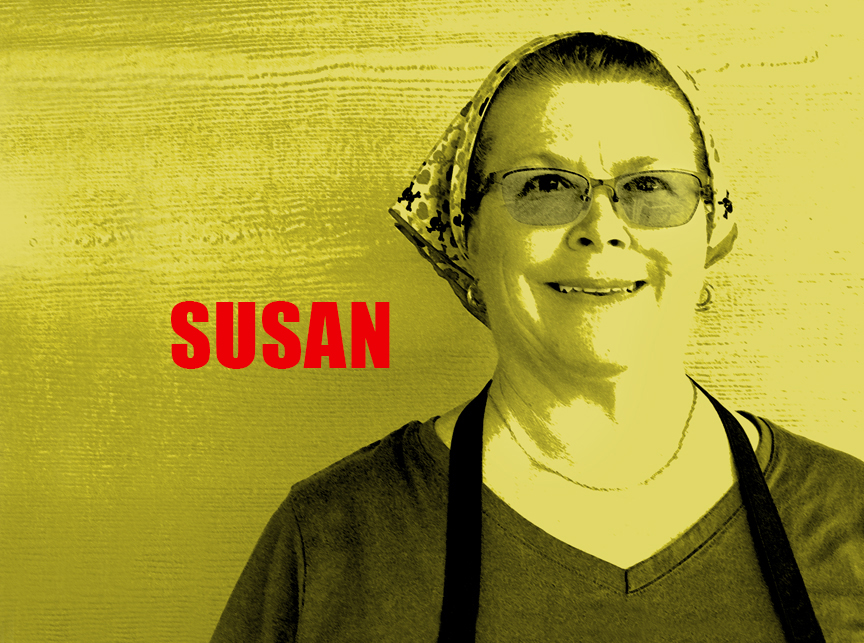
REBECCA AND SUSAN, ARTISANS/CO-OWNERS OF THE WILDFLOUR ARTISAN BAKERY & GRILL.
The Wildflour artisans.
Artisan simultaneously refers to who makes something (an artisan), what they make it with (artisanal ingredients) and how they make it (artisanal methods).
Sounds like Rebecca, Susan and The Wildflour.
Rebecca and Susan, the artisans behind The Wildflour Artisan Bakery & Grill have crafted every aspect of the Wildflour experience.
First, Location.
Location. Location. Location. It’s the bedrock of every successful restaurant.
The Wildflour’s location is easily accessible from Canyon Lake, River Road and nearby river tubing companies. The building had been a bakery and restaurant for 20+ years so the bones of a restaurant were there, making it a great starting point.
Rebecca and Susan took it from there and finished a complete redesign and renovation, inside and out, to make it theirs.
The result? A casual, fun dining experience that creates the perfect atmosphere for their eclectic menu.
Their approach and philosophy?
According to Rebecca, “We wanted to bring fresh, new artisanal foods to the hill country. Susan has perfected the process for smoking Turkey, Salmon, Venison and Chicken which are some of our most popular items. My signature dish? Cheesecake. I take a basic cheesecake recipe and create new ideas including our Pecan pie cheesecake (you get pie and cheesecake) or our Red Velvet Cake Cheesecake (cake baked right inside of the cheesecake). We take pride that most of our menu items are made entirely in-house.”
Rebecca and Susan haven’t had formal culinary institute training. Even so, are they cooks or chefs? A cook follows established recipes to prepare food. A chef is trained to understand flavors and cooking techniques, create recipes from scratch with fresh ingredients, and has a high level of responsibility both in and out of the kitchen including updating menus and handling administrative tasks like schedules and payroll.
Their combined real-world training has given them chef-level skills and abilities. Combine that with their intuitive interest and love of creating artisnal food and, as far as I’m concerned, you have a “chef” inspired experience at the Wildflour.
Wildflour Artisans’ Food Portfolio.
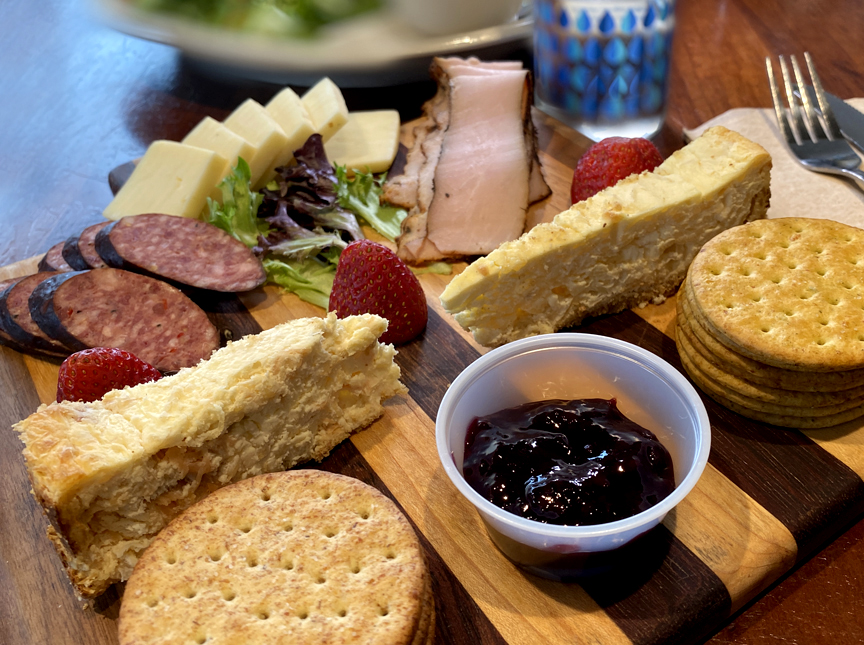
HOUSE SMOKED MEAT & CHEESE BOARD. HOUSE-SMOKED VENISON SAUSAGE AND TURKEY, HOUSE-MADE SOFT SAVORY WHITE CHEDDAR CHEESES AND CRACKERS WITH A HOUSE-MADE TRIPLE BERRY JAM.
It’s hard to pick a favorite from this combo. The smoked meats. The cheeses. The jam. It’s a yes to all three.
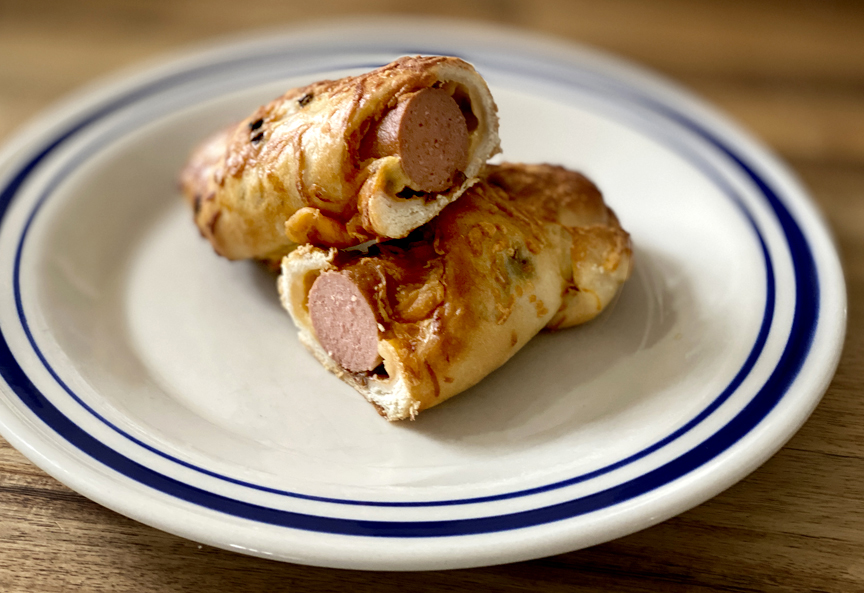
HOUSE-SMOKED VENISON JALAPENO KOLACHE
These are the best kolaches we’ve had anywhere. Also try their regular venison kolache.
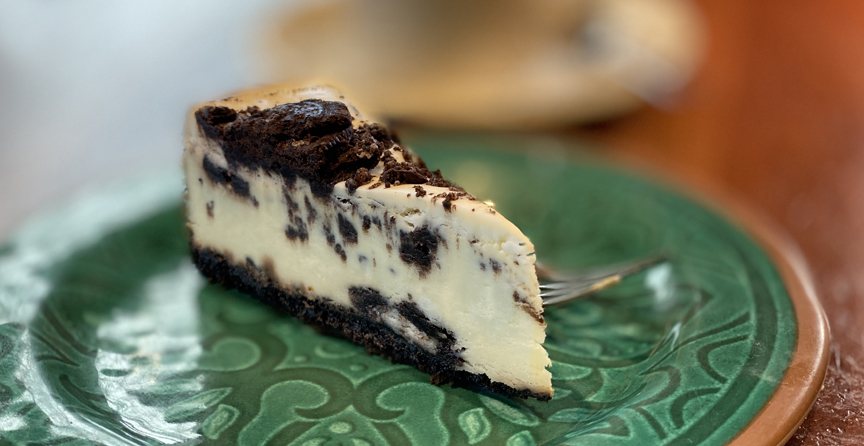
COOKIES & CREAM CHEESECAKE.
Love all of their cheesecakes but this is one of our favorites.
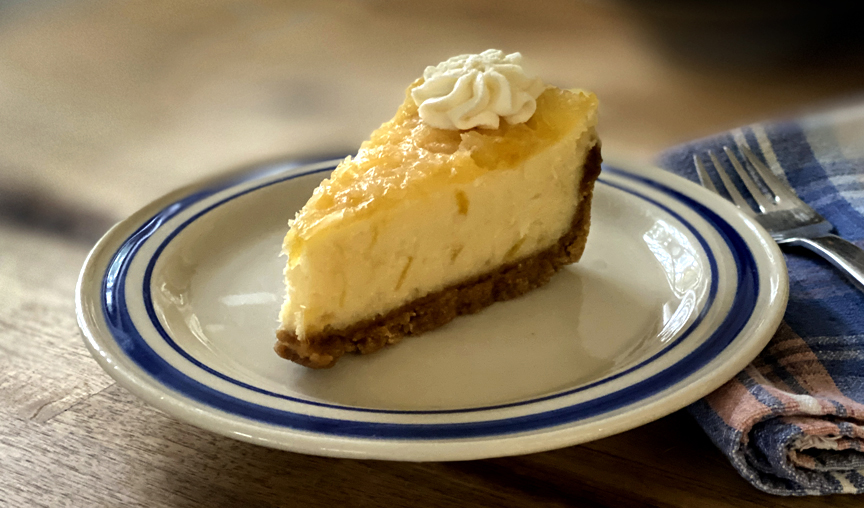
PINAPPLE AND COCONUT PINA COLADA CHEESECAKE.
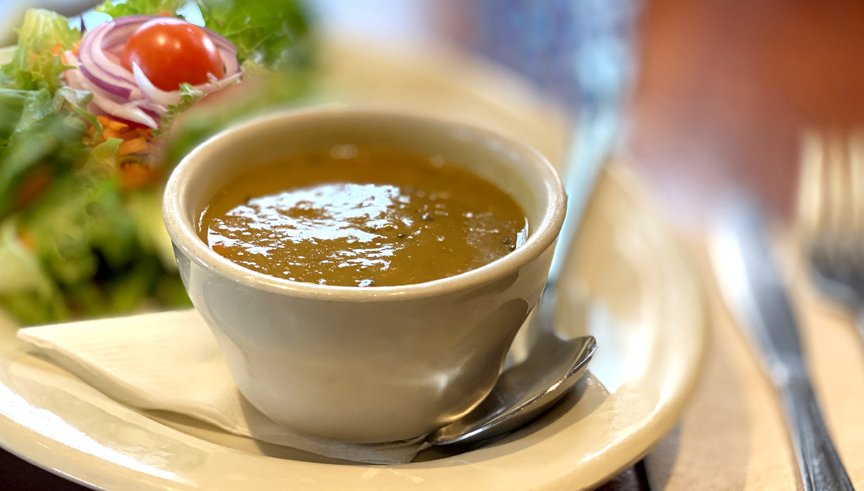
HOUSE-MADE SPLIT PEA SOUP.
Their split pea soup is a must-have special that isn’t a regular menu item so make sure and look for it on the daily board the next time you visit the Wildflour.
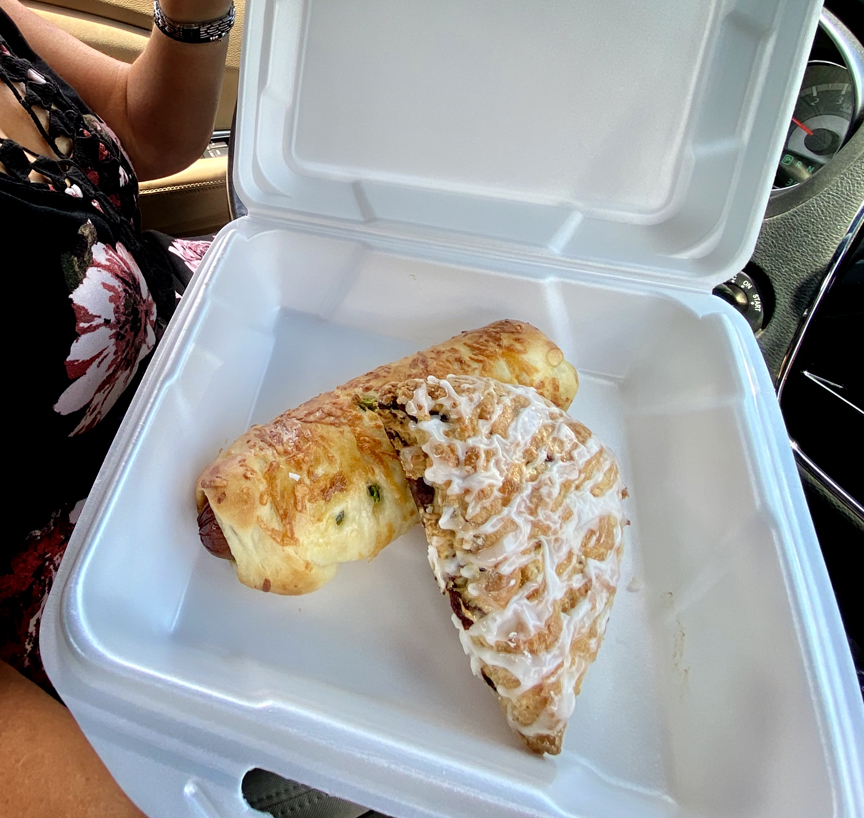
BACKBONE ROAD TRIP TIP. When you’ve finished eating at Wildflour, get a to-go box for the road

The Devil’s Backbone. History, Facts and Possible Facts.
WHAT IS THE DEVIL’S BACKBONE? 30 Million years ago an earthquake in what is now Central Texas created a limestone ridge and formed the Edward’s Plateau to the west and the lower Gulf Coast Plains to the east. It’s a scenic area that stretches through the Texas Hill Country between Wimberley and Blanco.
HOW ABOUT GHOSTS ON DEVIL’S BACKBONE? There are two sections of Devil’s Backbone that are responsible for it’s haunting reputation.
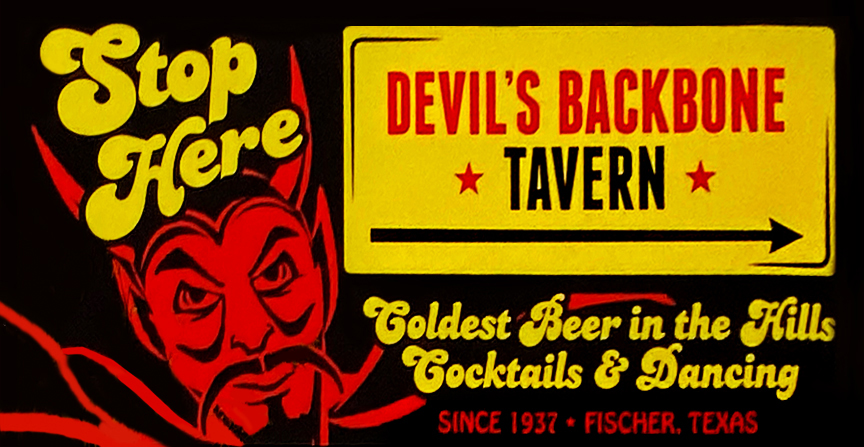
THE FIRST SECTION is the site of the Devil’s Backbone Tavern (still in operation today across the road from The Devil’s Backbone Overlook).
According to the Tavern, their site started with a single stone room built for a blacksmith’s shop/stagecoach stop at the base of a treacherous trail in the 1890s. After prohibition, the tavern was built and, in the 1950’s, a service station and package store were added.
The Tavern’s most famous ghost story describes a woman who walks down the road and is carrying a baby and calling out for her husband.
THE SECOND SECTION according to Wimberly’s Blair House Inn web-site is around the aptly named Purgatory Road. The stories that originate there claim sightings of Spanish monks, Native Americans and Confederate soldiers.
Jenny Webster Jurica, writing for TexasHillCountry.com, describes tales of the ghost of a Native American named Drago who has been seen herding cattle along the backbone and of ranchers who also tell of a widow and child of a miner who was killed, wandering the area, supposedly seeking a proper Christian burial for their husband and father (a variation on The Devil’s Backbone Tavern version).
She also writes about an apparition that is said to materialize on the hoods of cars as they drive along.
AS FOR US? We’ve driven these roads multiple times at every time of day and night and have yet to come across any occupants slipping over from the other side. But, then again, maybe we just don’t know what to look for.
Planning the Devil’s Backbone Run.
Research for The Devil’s Backbone run uncovered a few crude maps and multiple articles that were a mix of Backbone history and course descriptions. Some of the articles did a good job of identifying the roads to take while others made references that were difficult to visualize or translate to a map.
None of the maps or articles gave you a turn-by-turn course with mileages.
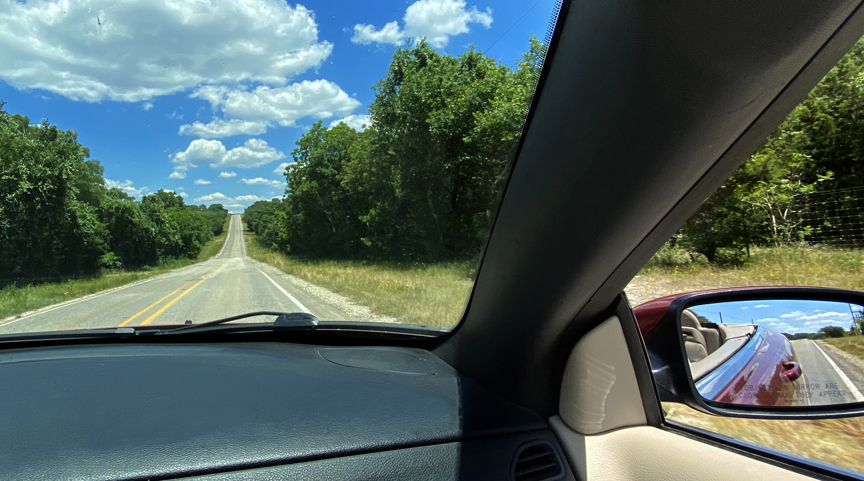
MUCH OF DEVIL’S BACKBONE CONSISTS OF HILLS YOU CAN SEE IN THE DISTANCE SNAKING UP AND DOWN THROUGHOUT THE COURSE.
So that became the challenge.
Create a turn-by-turn course with mileages. And a map. A really good map.
Since we spend a lot of time exploring the roads around Canyon Lake, I included the scenic River Road prologue to the Backbone plus a technical section on Hugo Road and added something special at the end. Even with add-ons, the total course is under 90 miles (plus 16.4 miles if you add the bonus ending) leaving plenty of time to stop along the way.
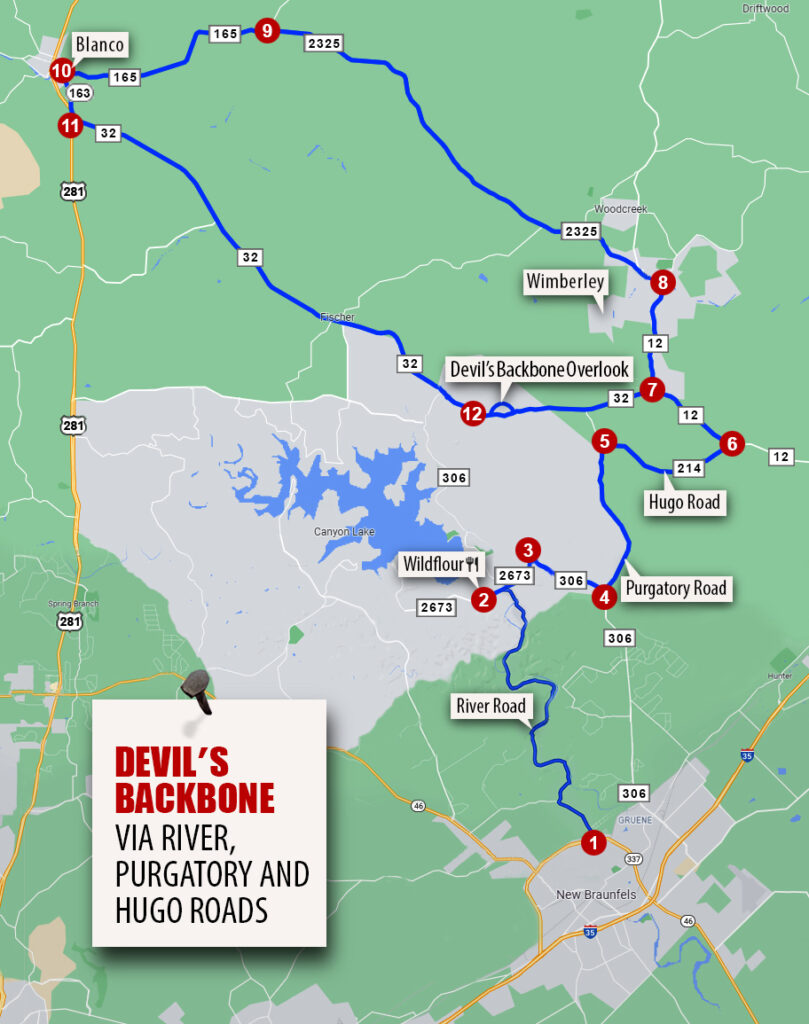
Out On The Road. Finding the definitive (we hope) Devil’s Backbone road trip (via River, Purgatory and Hugo Roads with a stop by the Wildflour and a special, bonus finish.)
This Devil’s Backbone run takes you through some of Central Texas’ best road trip courses and destinations. Here are turn-by-turn directions keyed to the Devil’s Backbone map (above).
1. START This is a prologue to the Devil’s Backbone route. To get to our first stop, The Wildflour Artisan Bakery & Grill, we started at the Southeast access to River Road at Loop 337 in New Braunfels. We drove toward Canyon Lake on River Road winding back and forth across the Guadalupe River. Pick the right day and you could be on the road at the same time as one of the local car/motorcycle clubs (most recently, we had 40-50 Mustangs go by including every year, model and custom combination you can imagine, from classic restorations to Shelbys). We can’t emphasize enough how much this drive adds to the trip. Travel 12.8 miles
TURN LEFT on FM 2673. Travel .4 miles
TURN RIGHT into The Wildflour.
2. HEAD OUT TO THE DEVIL’S BACKBONE RUN. After you finish breakfast (or brunch/lunch) at the Wildflour,
TURN LEFT on FM 2673. Travel 1.8 miles
3. NEXT TURN RIGHT on FM 306. Travel 2.9 miles
4. NEXT TURN LEFT on Purgatory Road. Travel 5.0 miles
5. NEXT TURN RIGHT on Hugo Road (FM 214). Travel 4.0 miles
Hugo is a great, short, technical section. If you like a fast run with turns, you’ll enjoy this section. For an alternate route, you can go straight on Purgatory to RR 12 and skip Hugo.
6. NEXT TURN LEFT on RR 12. Travel 7.7 miles
7. OPTIONAL TURN If you want to end your Devil’s Backbone Run in Wimberley, then turn left on FM 32 and head towards Blanco. Refer to the map to finish the course if you take this option. Since we’ve been to Wimberley on multiple occasions (and had a bonus course end planned), we stayed on RR 12 for the full 7.7 miles.
8. NEXT TURN LEFT on FM 2325. Travel 15.7 miles
9. NEXT TURN LEFT on FM 165. Travel 7.5 miles
ARRIVE IN BLANCO A great stop for BBQ, coffee or antique shopping.
10. NEXT TURN LEFT on TX 163, merge onto US 281. Travel 2.1 miles
11. NEXT TURN LEFT on FM 32. Travel 18.3 miles
START LOOKING TO YOUR LEFT AT 17 MILES: Look for the Devil’s Backbone Overlook, a small roadside park that looks down on the valley that defines Devil’s Backbone.
12. NEXT TURN LEFT into Devil’s Backbone Scenic Overlook.
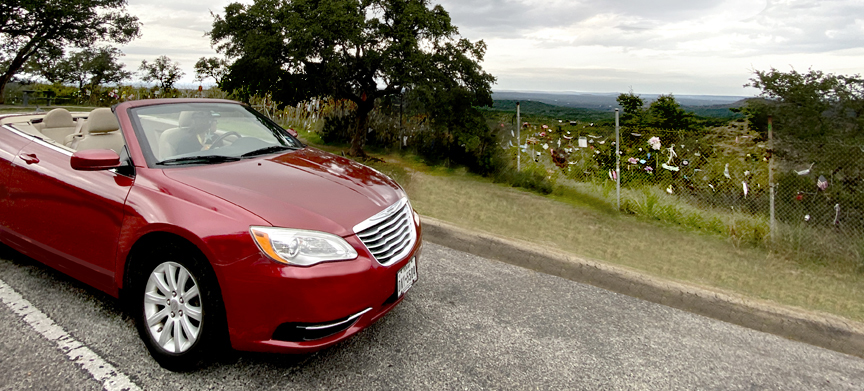
THE DEVIL’S BACKBONE OVERLOOK.
The Devil’s Backbone Scenic Overlook is just past the Canyon Lake detour and gives you the opportunity to stop and take in the picturesque views. If you brought a picnic with you, this is a good spot to enjoy it! Or, you could stop by the Devil’s Backbone Tavern just across from The Overlook to grab a drink.
BONUS FINISH: For the perfect end to a perfect trip, we pulled out of the Overlook and headed to Black’s Bar B Que on Loop 337.
WE TURNED LEFT on FM 12, Traveled 2.5 miles
THEN TURNED RIGHT on Purgatory, drove South to FM 306, Traveled 5.4 miles
TURNED LEFT on FM 306. TURNED RIGHT on Common and headed to Black’s Bar B Que on Loop 337. Traveled 9.6 miles
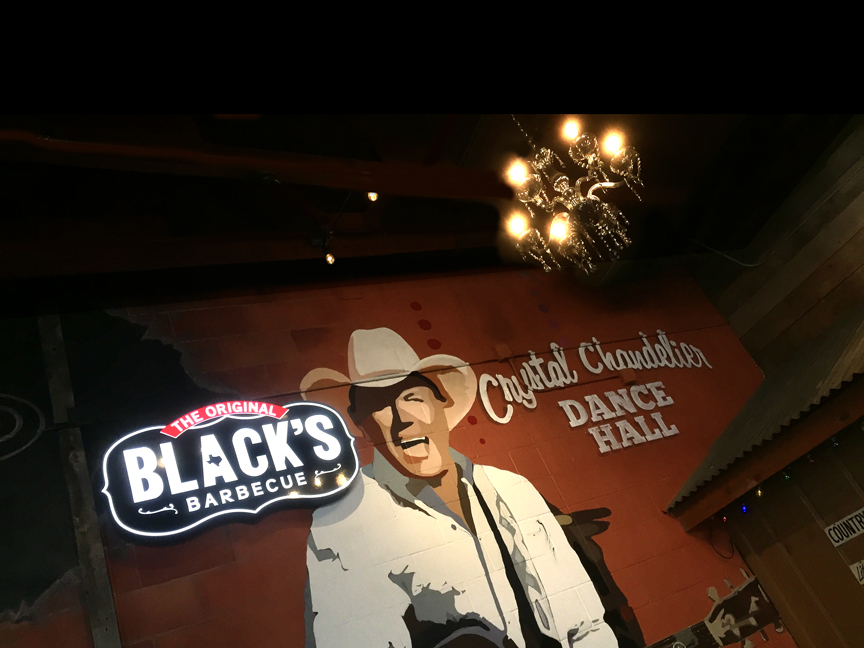
DID YOU EVER GO TO THE CHRYSTAL CHANDELIER DANCE HALL? THE ORIGINAL CHRYSTAL CHANDELIER FROM THAT WELL KNOWN CLUB IS AT THE NEW BRAUNFELS BLACK’S BAR B QUE.
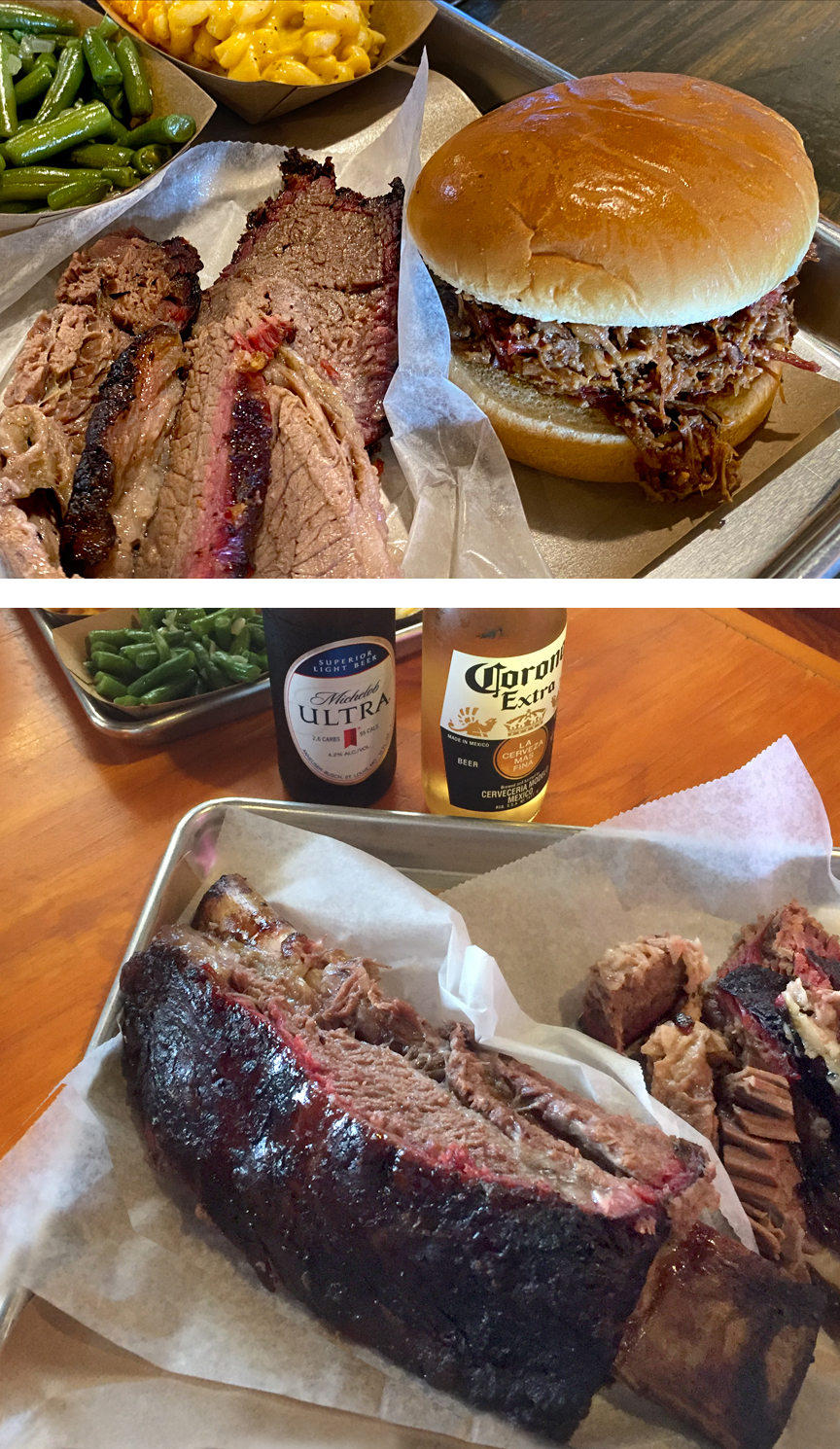
BLACK’S BAR B QUE (ABOVE) MOIST BRISKET, SHREDDED BRISKET WITH MAC & CHEESE AND GREEN BEAN SIDES. (BELOW) BLACK’S MUST HAVE GIANT BEEF RIB COMES IN AT ABOUT A FULL POUND AND IS AN AWESOME EXPERIENCE.
Wildflour Artisan Bakery and Grill, 2000 FM 2673, Sattler, Texas Black’s BBQ, Loop 337, New Braunfels, Texas.
NEW! WE’VE ADDED EXTERNAL LINKS TO HELP GET YOU WHERE YOU WANT TO GO. Look for the light blue External Links (above) added to the hotels, restaurants and destinations we’ve visited making it easier to research and plan your next trip.
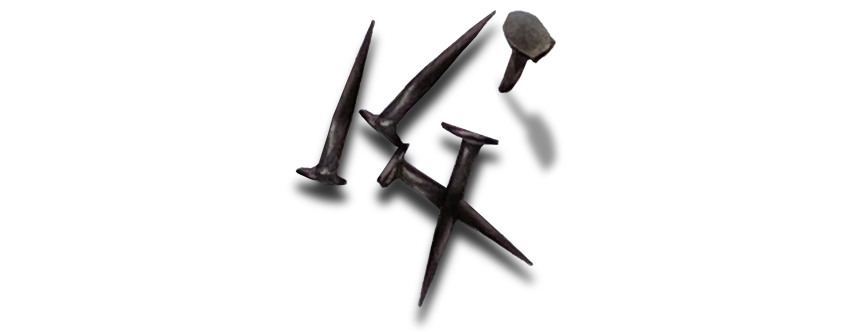
#roadtrip #devilsbackbone #wildflour #blacksbbq




FEBRUARY 18, 2022 POST: The Devil’s Backbone run via River, Hugo and Purgatory Roads with a stop by the Wildflour and a bonus ending. READ MORE
OCTOBER 21, 2021 PREMIER POST: Brance Arnold and Sonic Radio at Koozies Ice House & Grill. Fellow traveler Walt at The Lighthouse Inn. READ MORE The Story Behind Road Portraits. READ MORE Shot on iPhone. READ MORE

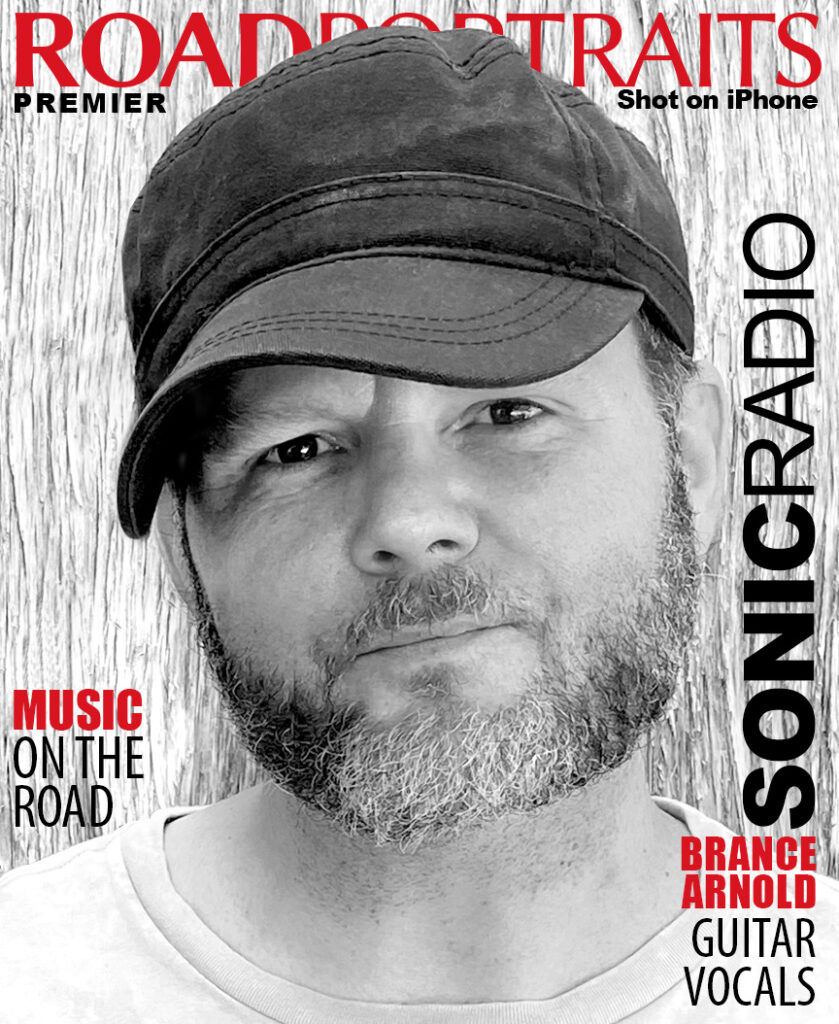
BRANCE ARNOLD / PHOTOGRAPHED AT KOOZIES ICE HOUSE & GRILL / NEW BRAUNFELS TEXAS
This is Road Portraits.
Portraiture is one of my favorite disciplines. With Road Portraits, I’m bringing portraits to Drop Top Road Trips. Portraits starting with musician Brance Arnold.
WRITTEN & PHOTOGRAPHED BY: STEVE HOLLOWAY.
I played in bands all through high school. It’s how I paid for guitars, amps and gear. And my first car, a Ford Galaxie. And my second car, a 1967 Ford Mustang.
One of my classmates was Christopher Cross. Yes. The Arthur’s (movie) Theme (The Best That You Can Do), Sailing, Ride Like The Wind Christopher Cross. I could play and I could make money playing but I wasn’t that caliber of musician. Still, I got to play with musicians that were in bands with him and I learned what really gifted musicians can do.
So I can tell you, first hand, there aren’t many musicians who can move effortlessly from one discipline to another.
Brance Arnold can.
Based out of San Antonio, this guitarist/vocalist divides his time between playing original and authentic Mississippi blues in Chacho & Brance, backing Vic Vega in Rod Stewart tribute gigs, providing guitar/vocals for Nashville/Austin/San Antonio singer, songwriter Ed Morales and performing with cover band Sonic Radio.
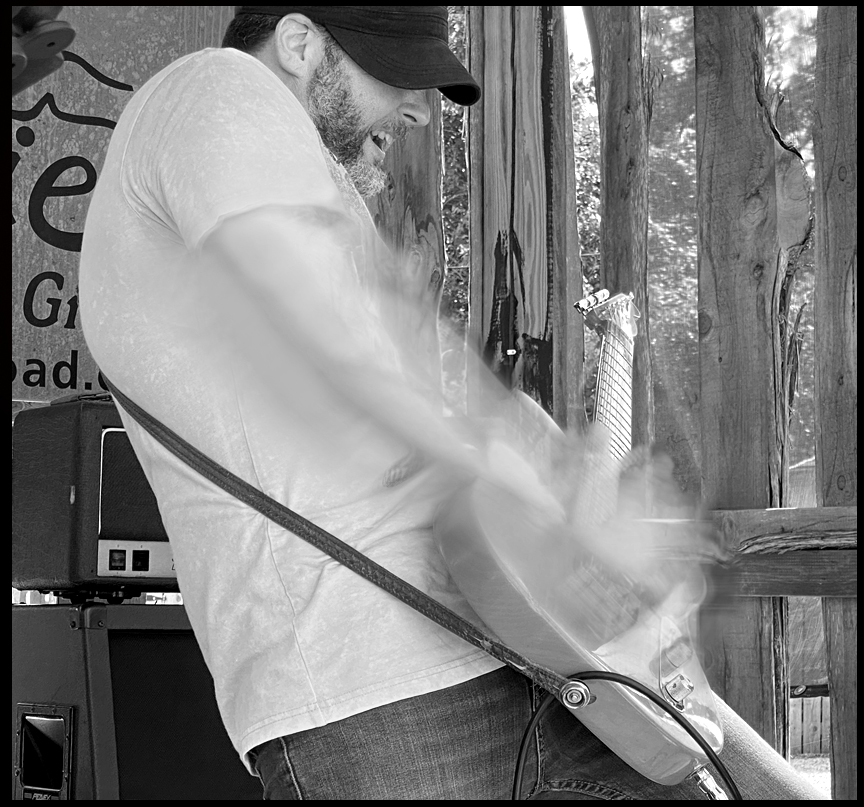
After several failed attempts to match our schedule to their calendar, we were able to catch up with Brance and Sonic Radio at Koozies on the Guadalupe River.
It was hot, like 98 degrees hot, but that didn’t stop them from delivering a solid 3 hours of killer rock and roll. Greatest hits and forgotten gems. From 80s hairmetal to 90s alternative to earlier tunes.
Look for Chacho & Brance, Vic Vaga, Ed Morales and Sonic Radio. Catch as many of their shows as you can. We’ve heard all four. All four are bad ass, dead on perfect.
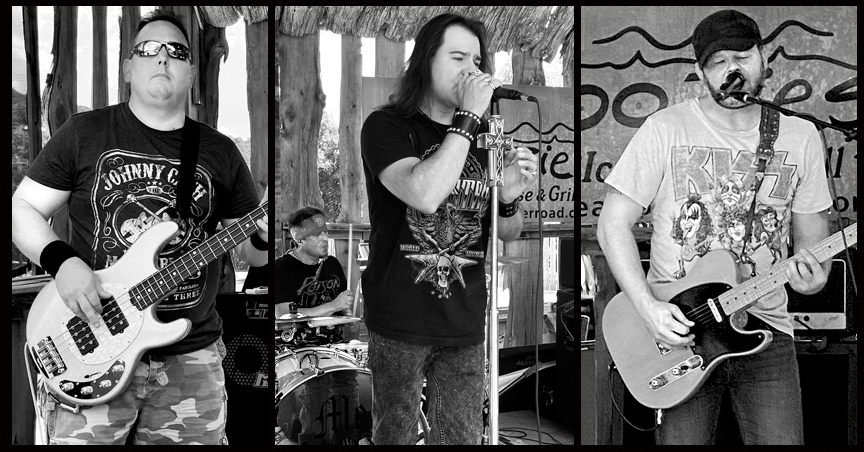
SONIC RADIO IS (L-R) CHRIS LOWRANCE (BASS), MONTE RAMIREZ (DRUMS/PERCUSSION), CHRISTOPER NEW (LEAD VOCALS), BRANCE ARNOLD (LEAD GUITAR/VOCALS)
Koozies Ice House & Grill 8515 River Rd, New Braunfels, Texas. Sonic Radio Cover Band, Gig Salad.
NEW! WE’VE ADDED EXTERNAL LINKS TO HELP GET YOU WHERE YOU WANT TO GO. Look for the light blue External Links (above) added to the hotels, restaurants and destinations we’ve visited making it easier to research and plan your next trip.


Sign up to receive Email Alerts whenever new posts are added to our Blog, Road Portraits, Travel News and Road Story pages. SIGN UP


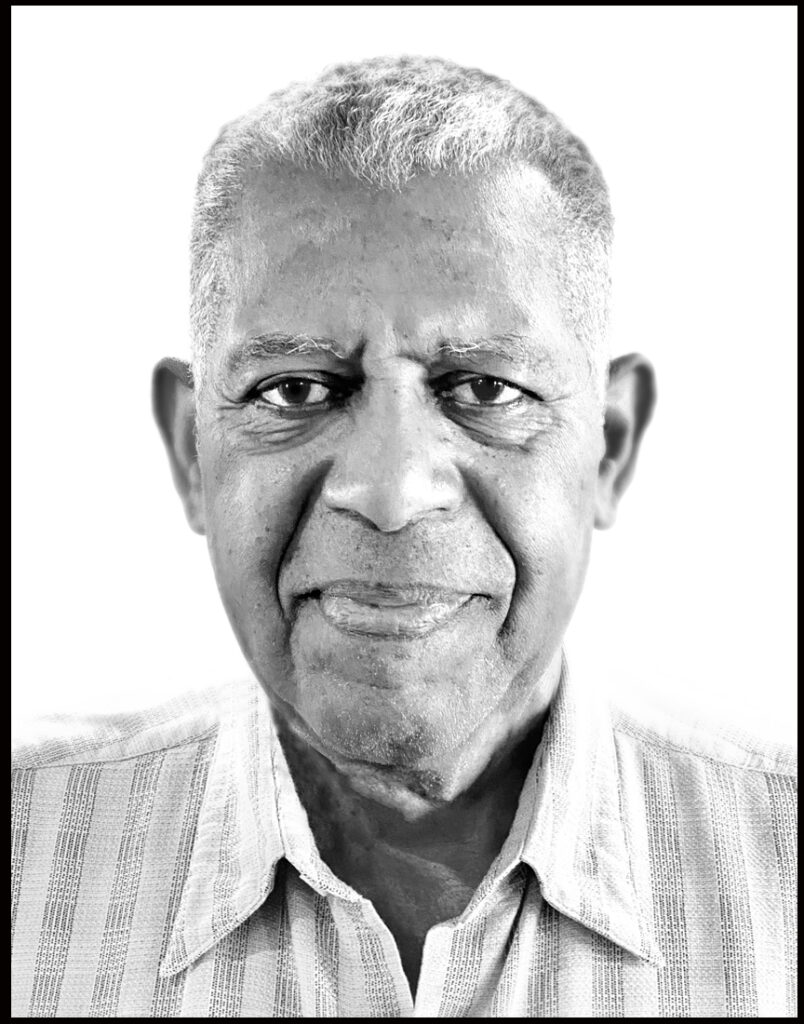
WALT / FELLOW TRAVELER / PHOTOGRAPHED AT THE LIGHTHOUSE INN / ROCKPORT TEXAS
On The Road, Back to The Beach.
WRITTEN & PHOTOGRAPHED BY: STEVE HOLLOWAY.
Ever have someplace you went to so often that you overdid it? You went so many times that you needed a break? That was us and the beach.
So we decided to skip a year. Then other trips came up and a year turned into three.
Then Hurricane Harvey happened and, for a long time, we just couldn’t bring ourselves to go back. To see what Harvey had done to the marinas, stores, restaurants and beaches in and around Port Aransas. Places we loved so much.
Finally, in 2021 we were ready. Ready to go back to the Texas coast. Back to the beach. Happily, the Port A we found was the Port A we remembered!
To get the total beach experience, we started with 3 nights in Port Aransas at the Gulf Stream Condos over Labor Day weekend. We’re talking people, families, and kids everywhere, swimming, cooking, digging in the sand.
That was followed by 3 nights at The Lighthouse Inn in Rockport, Texas. Labor Day weekend was over so it was just us and maybe 5 other couples. Peaceful. Quiet. The perfect contrast to the holiday weekend atmosphere of the first 3 nights.
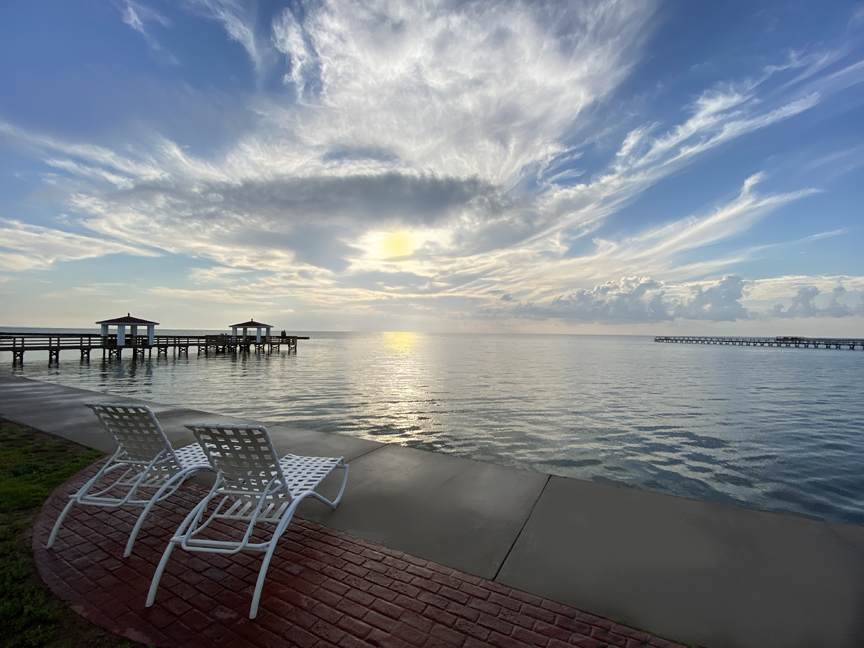
ROCKPORT. The relaxing view of the bay from outside our room at The Lighthouse Inn. This 78 room historic hotel dates back to the early 1900s. After Harvey hit, the Lighthouse got a face lift so staying there now is an authentic experience much like the you would have had in their early days.
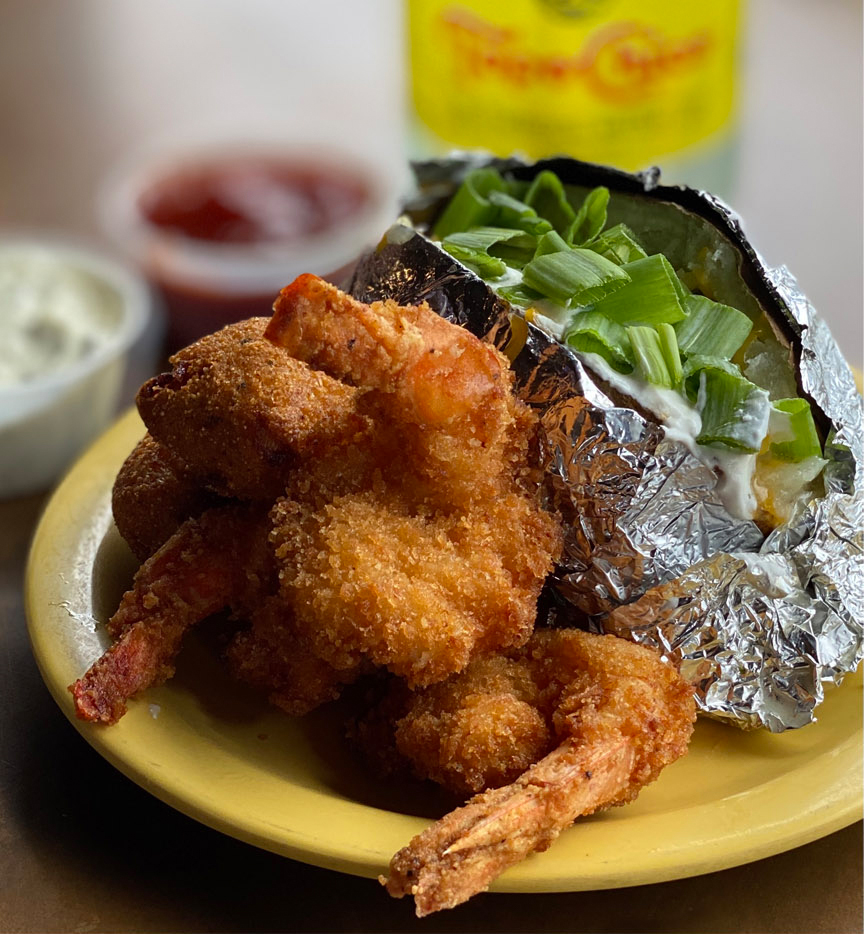
PORT ARANSAS. While you’ll find fried fish all over Port A (and believe me, we tried more than one), some of the best we ate was at Virginia’s On The Bay. We had oysters and, of course, shrimp (Port A is known for its’ fishing and shrimping industries). Straight from the bay, breaded and cooked to perfection, served with an awesome baked potato.
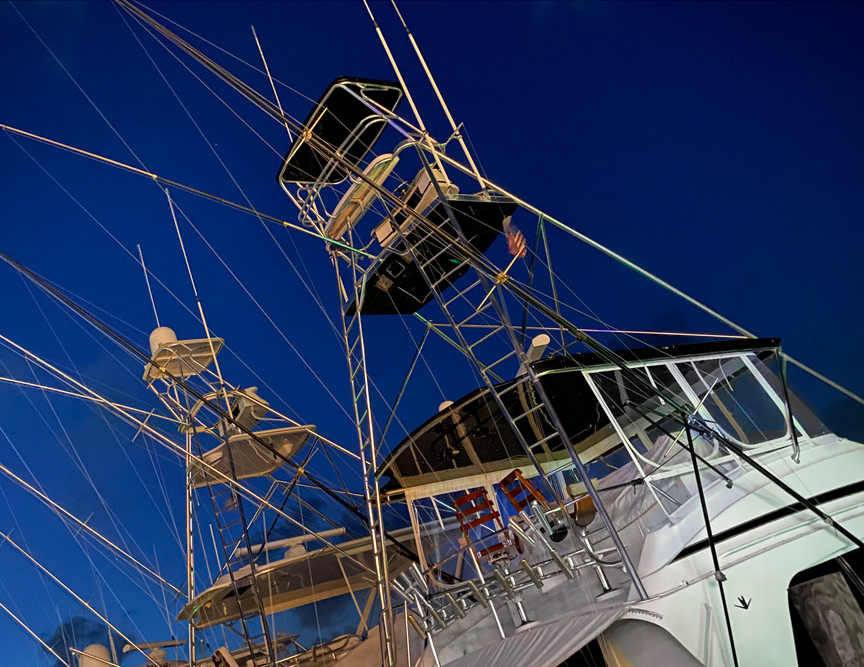
And, when they say “on the bay”, they mean the sitting at your table, watching the fishing boats, chased by gulls, come in for the day while you look at the marina and the boats on the dock kind of “on the bay”. Virginia’s is the perfect accent to the beach experience.
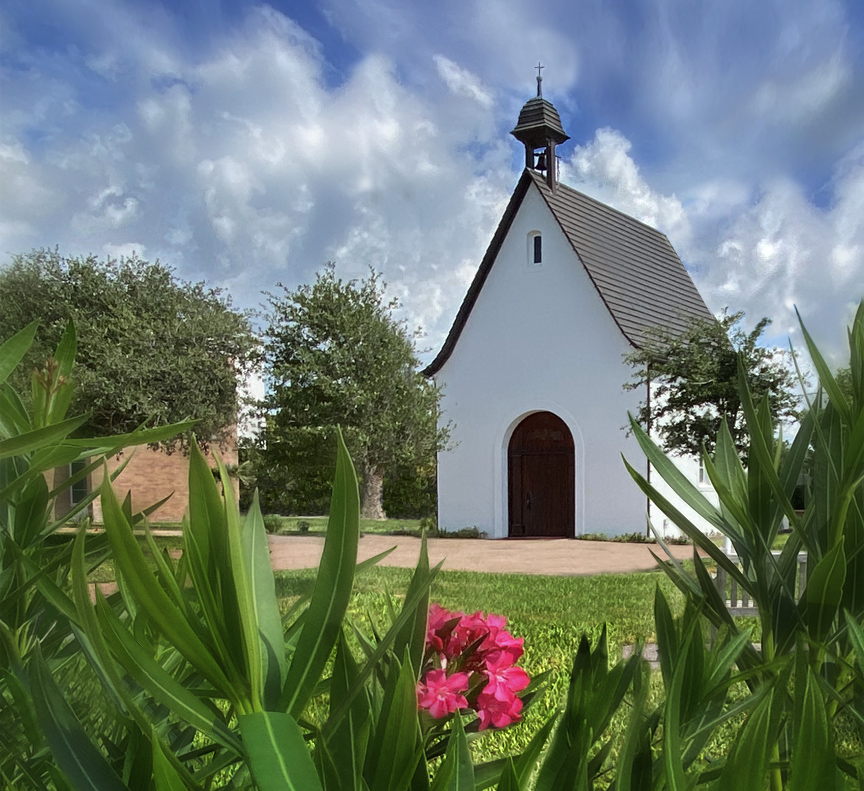
ROCKPORT, The Shoenstatt Shrine. It was in Rockport at The Lighthouse Inn that we met fellow traveler Walt. He and his wife were traveling with another couple. Walt and his friend are both retired Navy officers.
The couple traveling with Walt told us not to miss seeing the Schoenstatt Shrine. Which is good because, if we hadn’t been looking for it, we never would have known this tiny jewel was there.
Set in tranquil surroundings with calming views of Copano Bay we found the smallest chapel I’ve ever seen. A chapel that is special to Walt’s friends because this is where they got married.
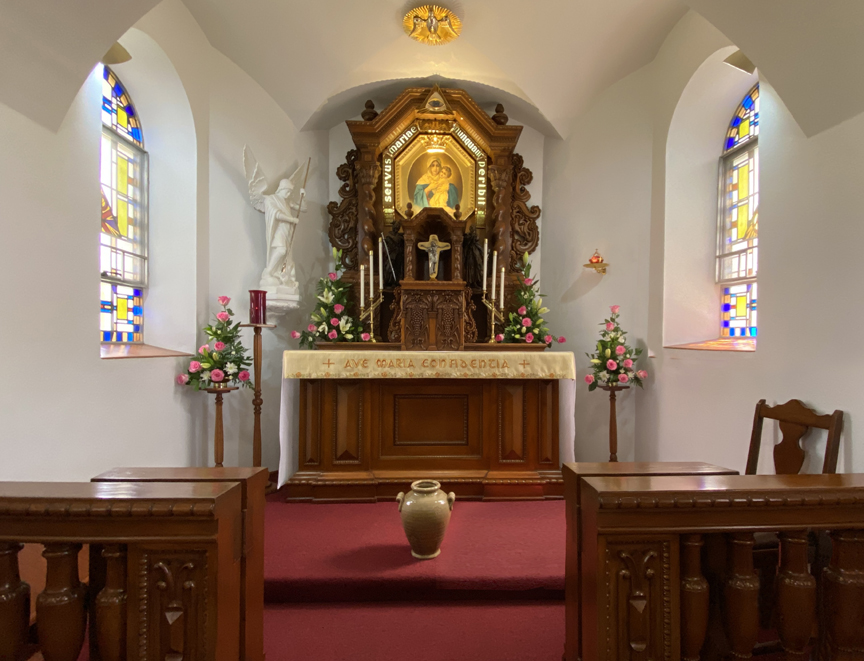
Located next to the Schoenstatt Sisters of Mary, the chapel’s design is based on the order’s original chapel (built in Germany in the early 1900s). There are 10 pews, each seating 2 people. 20 in all. Other Schoenstatt Shrine chapels are located as close as Helotes, Texas and as far away as South America and South Africa. Today, The Schoenstatt Order has grown to over 1800.
Lighthouse Inn 200 Fulton Beach Road, Rockport, Texas. Virginia’s On The Bay 815 Trout Street, Port Aransas, Texas. Our Lady of Schoenstatt Shrine 134 Front Street, Rockport, Texas.
NEW! WE’VE ADDED EXTERNAL LINKS TO HELP GET YOU WHERE YOU WANT TO GO. Look for the light blue External Links (above) added to the hotels, restaurants and destinations we’ve visited making it easier to research and plan your next trip.


Sign up to receive Email Alerts whenever new posts are added to our Blog, Road Portraits, Travel News and Road Story pages. SIGN UP


The Story Behind Road Portraits.
As I said at the top of this post, portraiture is one of my favorite disciplines. My portraits are influenced by the large scale Polaroids and Paintings of Chuck Close, the Photo-realist Portrait Painter who died, recently, at age 81.
Photo Realist Portrait Painter Chuck Close’s working process, Polaroids and paintings completely changed the way I look at portraiture.
WRITTEN & PHOTOGRAPHED BY: STEVE HOLLOWAY WITH IMAGES BY CHUCK CLOSE.
Arguably our most significant contemporary painter, Chuck Close redefined our understanding of the portrait.
I always went for the smile, the open inviting, friendly smile. Chuck Close went for just the opposite.
I recall watching a video of a Polaroid photography session (Close used Polaroids with grids added to them as guides to scale up for his paintings, working from 20×24 Polaroids in earlier portraits and as large as 40×40 Polaroids later on). He explained to his subject not to worry about smiling, that actually he was “looking for no affect at all”, no emotional facial expression.
That phrase, “looking for no affect at all”, really stuck with me.
Close’s idea was that you learn more about a person when you don’t let facial expression affect what you see. Take the smile away and you have to keep looking deeper to decide how you feel, to form an opinion about what you see. You become aware of details you otherwise overlook. The texture and “landscape” of the skin. The ears, eyes and hair. It changes your experience with the image and the subject.
Chuck Close’s work makes portraiture more than just “putting a face to a name”.
It uses the portrait as a portal to better understand the person it depicts. As you study a face, you gain some insight into someone you’ve known for years or even form a relationship of sorts with someone you’ve never met before.
Starting in the 60s, Close used tiny color dots to create photo-realistic images (his early work proved the concept of small “dots” forming a realistic image years before the first digital, ink jet image was conceived). Then, starting in the 80s, his paintings changed after an event that mostly paralyzed him and limited his ability to move and paint.
Working from the Polaroids he took, Close created his later paintings by starting with tiny abstracted shapes that, when viewed together at a distance, create mural-scale photo-realistic imagery.
Through both his Polaroids and his paintings, Chuck Close single handily changed the importance of both the portrait and of photography in the art community giving them both the significance and standing they deserve. Today, his Polaroids and his paintings are equally sought after.
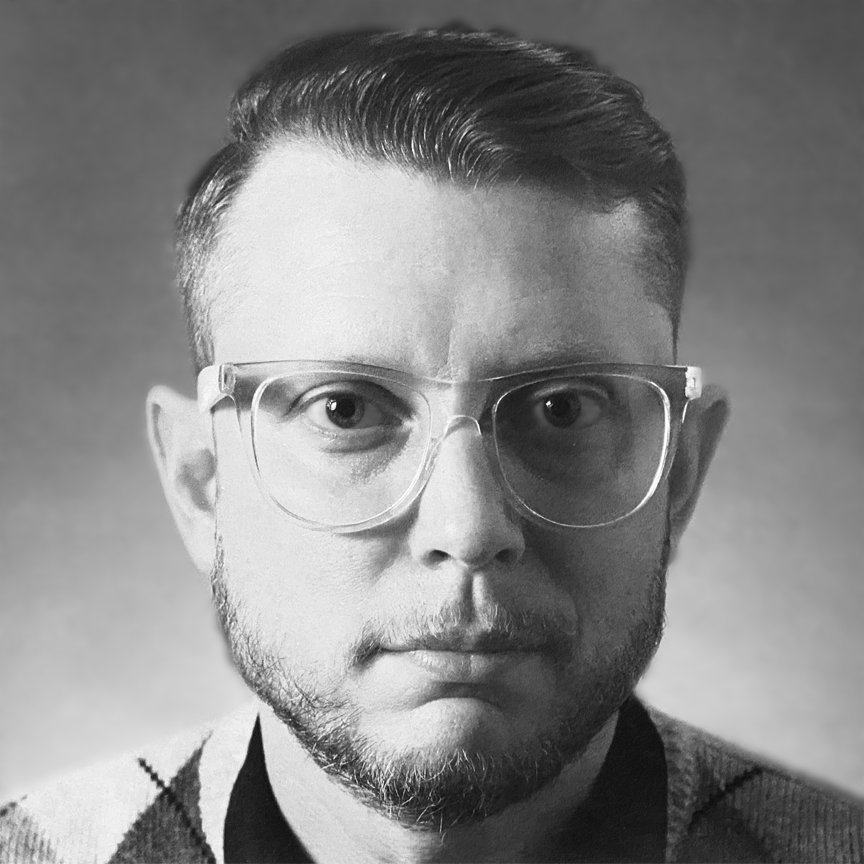
CHRIS 2016 / DIGITAL IMAGE © STEVE HOLLOWAY
This portrait reflects how Close has influenced my approach to portraits.
Chuck Close bio and past exhibitions at Pace Gallery.


WRITTEN & PHOTOGRAPHED BY: STEVE HOLLOWAY.
Road Portraits are/will be shot on iPhone. iPhone? Yes iPhone.
Why? The biggest problem photographers deal with is seeing a great shot happen right in front of them and not having a camera with them. Ever since the iPhone 4 came out, that problem was solved for me. I had a camera with me all the time.
So how good a solution is shooting with an iPhone instead of a DSLR?
To answer that, I looked at the digital cameras I’ve used over time as an assignment photographer.
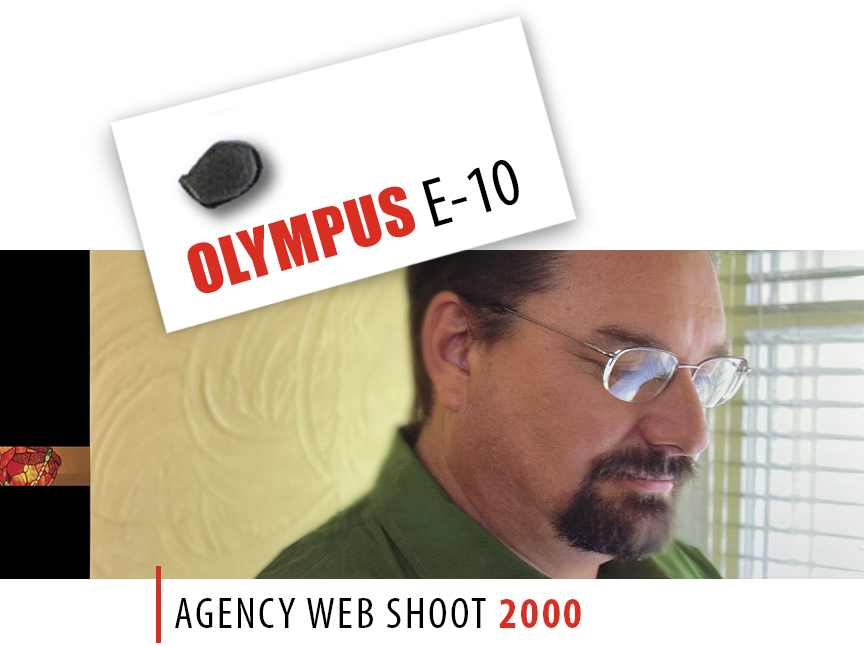
OLYMPUS E 10: The Olympus E 10 was my first digital camera. Introduced in 2000, it was also the first digital SLR designed for commercial assignment work. The Olympus E 10 had a CCD image sensor. The images it produced had harsh skin tones and lacked all of film’s finesse and smoothness in faces, eyes, arms and hands.
That didn’t matter.
Starting literally the day the E 10 became available, every ad agency, design firm and commercial account insisted on digital images. Why? Because it eliminated the time involved and cost of film, processing, color separations and proofs. It was faster and cost less.
The E 10 was marketed as a true 4 megapixel image sensor camera. Significant because every other digital camera at the time claimed to have a 4 megapixel image capture but actually used a 1.7 megapixel image sensor and did an automatic, forced interpolation to save the image like it was a 4 megapixel capture.
Needless to say, the Olympus E10 images were the cleanest available.
Even so, at only 4 megapixels they still produced artifact-laden images full of digital noise and debris. Every arc, radius and rounded corner was made of noticeable stair step fractals that required a combination of blending and blurring to make them visually “disappear”. Learning Photoshop on those images turned into an indispensable skill set for creating clean, detailed images.
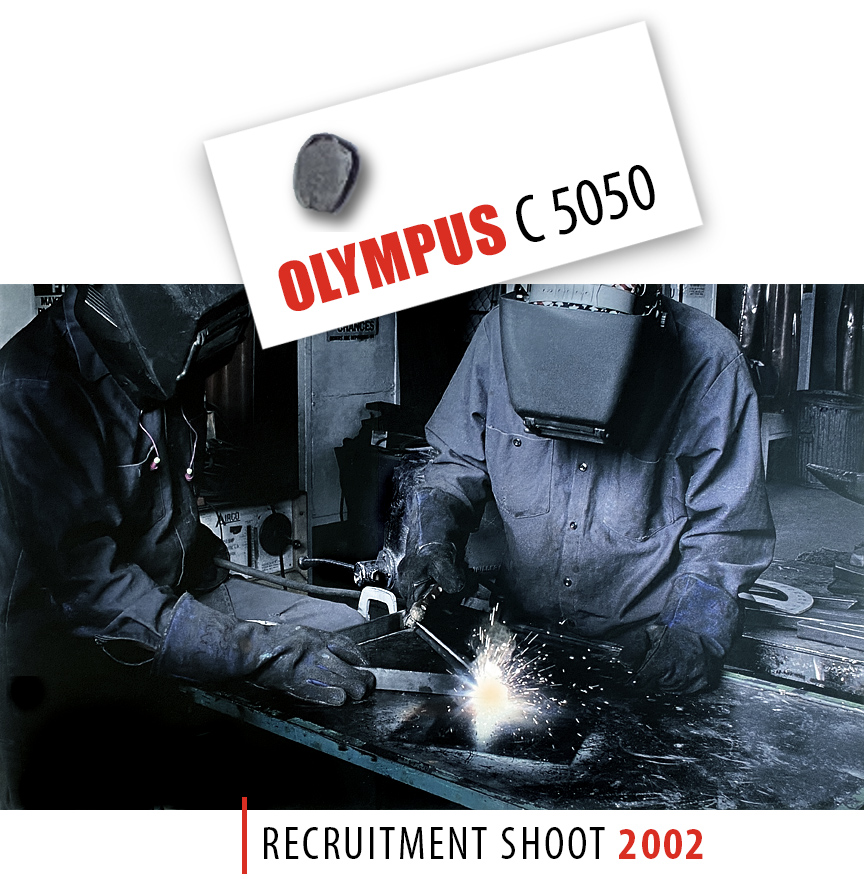
OLYMPUS C 5050: Next, in 2002, came the Olympus C 5050 with a 5 megapixel CCD image sensor. Not perfect but a larger file size and better image capture sped up post production turnaround.
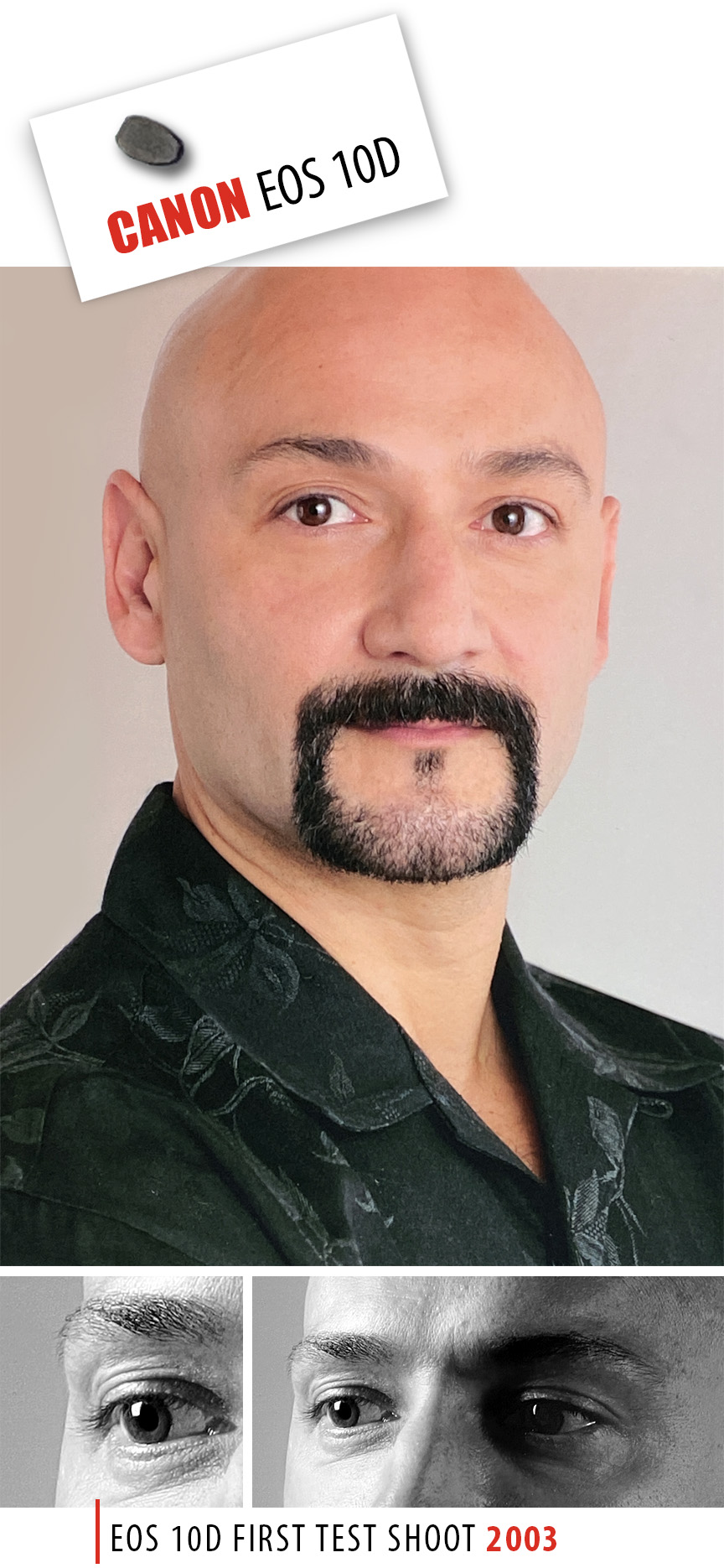
CANON 10D: Then, in 2003, Canon introduced a game changer. The EOS 10D with 6.3 megapixel CMOS image sensor. CMOS instead of CCD image capture technology. The detail and skin tones you could achieve with CMOS was phenomenal. The digital noise and debris were virtually nonexistent and you could scale images up to almost any size.
In 2004 I upgraded to the new Canon EOS 20D with 8.2 megapixels then, in 2010 I added the new EOS 7D with an 18 megapixel image sensor. I shot with the 7D and 20D until I retired in 2017.

PRODUCT AND ARCHITECTURAL IMAGES SHOT ON ASSIGNMENT WITH THE OLYMPUS E 10 AND C 5050
Now, Back to Why iPhone.
If you remember, I said the problem of not having a camera with me all the time was solved with the iPhone 4. So where was I as all the prior iPhones came out?
First I have to admit that, when it comes to cameras, I’m an early adopter. I was always ahead of the curve. It made my job easier and it kept me competitive with agencies and design firms.
But when it came to cell phones, well, I was not only a late adopter, I was a resistant, reluctant adopter. I still remember the first cell phones. Very expensive “bricks” with about 3 hours of talk time. I just couldn’t justify the expense.
It wasn’t until about the time flip phones came along and were easily available and affordable, that I got my first cell phone. Still, I looked at cell phones as phones. You receive calls, you make calls plus you get voicemail in the deal.
The iPhone 4 was my first smartphone. Why?
Because my flip phone quit working and there weren’t any more flip phones available. Not one. Not anywhere. So I was dragged, kicking and screaming, into current technology.
Next up, the iPhone 6.
By the time I upgraded to the iPhone 6, not only had I realized the advantage of having the camera with me all the time but I hardly used my laptop anymore since I was getting all my emails and doing all my internet searches/access there too.

THE AUSTIN SKYLINE / © STEVE HOLLOWAY
My timing couldn’t have been better. The iPhone 6 was one of the first smartphones that started getting used as viable image capture for video projects and it had Shot on iPhone 6 billboards created from users’ images (While the Austin skyline image above wasn’t used on an Apple billboard, it was shot on my iPhone 6) .
Today, I shoot an iPhone 11 Pro Max.
Remember that game changer, the Canon EOS 10D, 6.3 megapixel CMOS image sensor? The 11 Pro Max has a 12 megapixel CMOS image sensor.
Let me say that again, the iPhone 11 Pro Max has a 12 megapixel CMOS image sensor!
That’s twice the size of the image capture sensor on my first CMOS Canon SLR. The iPhone 11 Pro Max has both super wide angle and telephoto lenses, all with 12 megapixel image sensors. And it’s always with me! All the time!
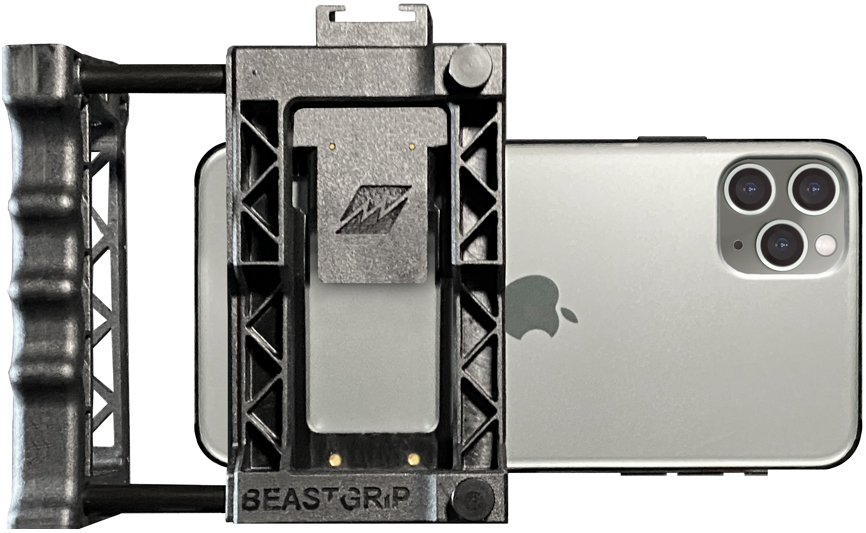
MY iPHONE 11 PRO MAX / BEASTGRIP RIG PROVIDES A FIRM GRIP POINT, ACCEPTS AN ON-CAMERA LIGHT ON TOP AND A QUICK-RELEASE PLATE ON THE BOTTOM TO ATTACH TO A TRIPOD OR BOOM ARM
Now, before I start getting emails about the physical size of the iPhone sensors vs. an APS-C or full frame sensor, let me say that while the smaller sensor has smaller pixels, current technology still manages to put 12 megapixels on an iPhone sensor. 12 megapixels!
To address the limitations of a smaller sensor size, Apple’s cameras have been designed to stabilize images, capture high dynamic range exposures, maintain depth of field, produce low light images and create shallow depth of field focusing effects.
And there’s not just one camera, the 11 Pro Max has three cameras and three lenses. A wide angle, an ultra wide angle 120-degree view and a telephoto. Each camera has a 12 megapixel sensor. Here’s the impressive part, all three cameras are paired together during manufacture, set to look at the exact same point. As you zoom in or out, the iPhone changes seamlessly from one camera to the other.
When you capture an image, all three cameras capture the same image or video. Then Deep Fusion, Apple’s neural image processing technology, uses artificial intelligence to merge images from different exposures into a single image or video. If one of the lenses didn’t capture parts of the image properly, Deep Fusion replaces those pixels with pixels from one of the other cameras to create the highest quality image or video possible.
Are there images that would benefit from a larger sensor? Of course. But everything I’ve needed to shoot for Drop Top Road Trips, I’ve captured easily with my iPhone 6 and now my 11 Pro Max. Cars, food, landscapes, driver POV images, road sides from moving vehicles, copy work, still lifes, portraits, high angle shots, low angle shots and architectural interiors/exteriors.
The overriding fact is having a camera with you, any camera, is better than not having a camera at all.
Sure, having the newest, most advanced camera with you at all times would be the perfect solution. But the reality is that it’s the photographer who makes the equipment they have on hand produce the result they are looking for. And, if you don’t have the skill set to do that, a different camera won’t save you.
Having worked through the evolution of the first digital cameras as a fulltime shooter, I know for a fact that if the only digital cameras available today were iPhones, every agency, design firm and commercial account would insist on iPhone digital image capture.
As a final note on my becoming an early adopter of smartphones, the iPhone 13 was introduced 2 weeks before writing this. I had been planning to upgrade to the 13 for over a month but now I’m seeing articles and media leaks describing new feature changes for the iPhone 14. Especially changes to the camera. So I’m torn. I might just wait 10 months for the 14.

#roadportraits #sonicradio #kooziesicehousegrill #lighthouseinn #virginiasonthebeach #portaransas #rockport



